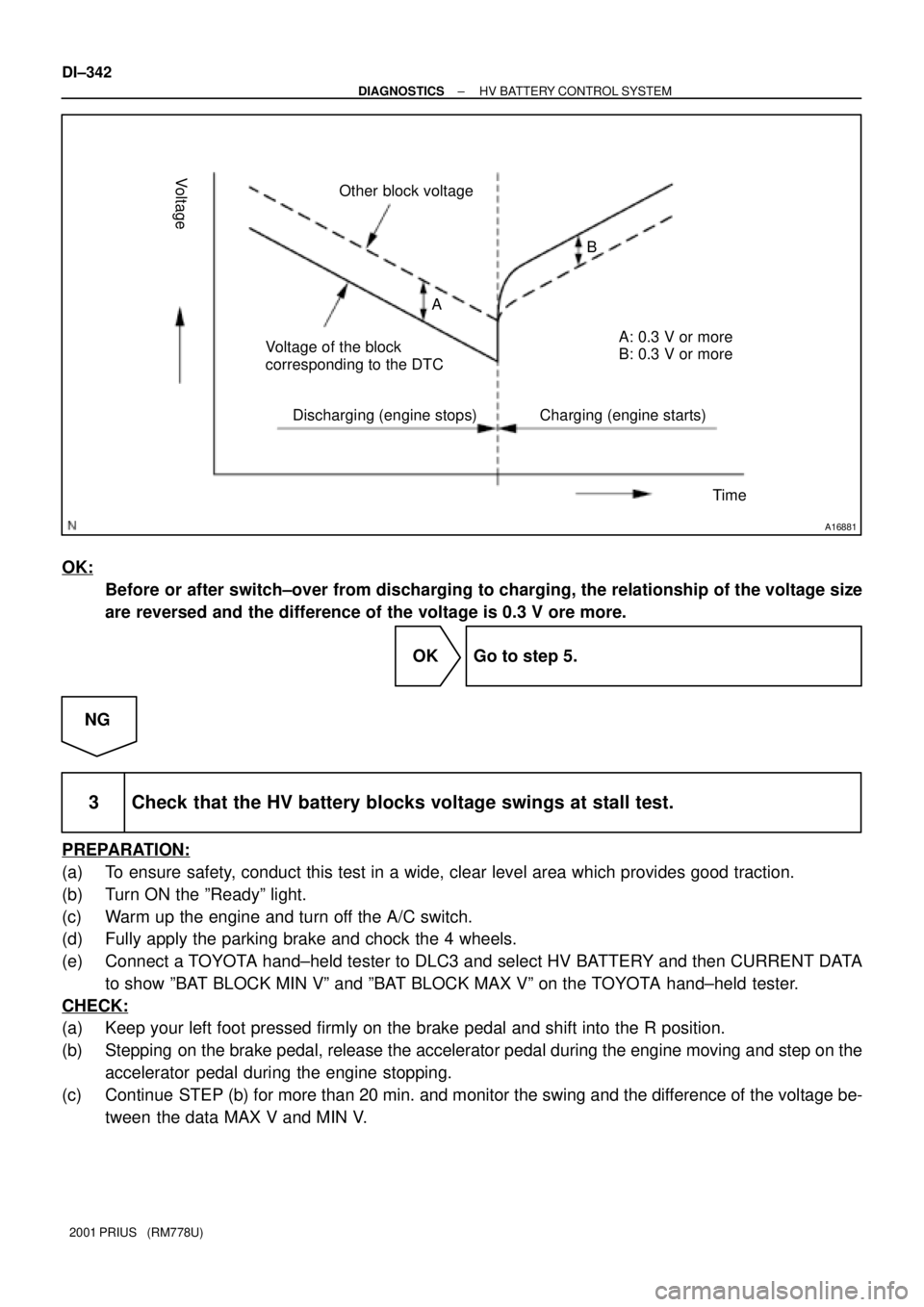Page 925 of 1943

A16881
Voltage
Other block voltage
Voltage of the block
corresponding to the DTC
Discharging (engine stops) Charging (engine starts)A: 0.3 V or more A
B: 0.3 V or more B
Time
DI±342
± DIAGNOSTICSHV BATTERY CONTROL SYSTEM
2001 PRIUS (RM778U)
OK:
Before or after switch±over from discharging to charging, the relationship of the voltage size
are reversed and the difference of the voltage is 0.3 V ore more.
OK Go to step 5.
NG
3 Check that the HV battery blocks voltage swings at stall test.
PREPARATION:
(a) To ensure safety, conduct this test in a wide, clear level area which provides good traction.
(b) Turn ON the ºReadyº light.
(c) Warm up the engine and turn off the A/C switch.
(d) Fully apply the parking brake and chock the 4 wheels.
(e) Connect a TOYOTA hand±held tester to DLC3 and select HV BATTERY and then CURRENT DATA
to show ºBAT BLOCK MIN Vº and ºBAT BLOCK MAX Vº on the TOYOTA hand±held tester.
CHECK:
(a) Keep your left foot pressed firmly on the brake pedal and shift into the R position.
(b) Stepping on the brake pedal, release the accelerator pedal during the engine moving and step on the
accelerator pedal during the engine stopping.
(c) Continue STEP (b) for more than 20 min. and monitor the swing and the difference of the voltage be-
tween the data MAX V and MIN V.
Page 926 of 1943
A16880
The difference of the voltage
between the date VMAX and VMIN
SwingVMAX data
The engine start Test startTime
Voltage
Swing
Swing
SwingVMIN data
± DIAGNOSTICSHV BATTERY CONTROL SYSTEM
DI±343
2001 PRIUS (RM778U) 4/27/01 OK:
Standard voltage swing: Less than 2 V
NG Replace the battery ECU (See page IN±41).
OK
4 Check the difference of the voltage between the data V MAX and V MIN.
Standard voltage difference: Less than 1.2 V
YES Replace the battery ECU. (See page IN±41).
NO
5 Replace the battery pack assembly, and initialize the battery ECU by performing
an active test.
Page 927 of 1943
A14077
Battery ECU
GR ± B Busbar Module
14
V ± Y 2
GR 15
O3
LG ± B 16
L ± O 4
LG 17
P5
Y ± B 18
L ± W 6
L7
LG ± R 20
Y8
P ± L 21
G9
L ± R 22
G ± W 10
R23
W11
L ± B 24VBB1
VBB2
VBB3
VBB4
VBB5
VBB6
VBB7
VBB8
VBB9
VBB10
VBB11
VBB12
VBB13
VBB14
VBB15
VBB16
VBB17
VBB18
VBB19
GBB19 DI±344
± DIAGNOSTICSHV BATTERY CONTROL SYSTEM
2001 PRIUS (RM778U) 4/27/01
DTC P3030 Battery Voltage Detective line Snapped
CIRCUIT DESCRIPTION
A voltage sensor set in a busbar module circuit measures a voltage of a pair of battery modules and sends
signals to the battery ECU.
DTC No.DTC Detecting ConditionTrouble Area
P3030Open in battery voltage detective line
�Battery ECU
�Open in battery voltage detective line
�Wire harness, Busbar module
WIRING DIAGRAM
DI82D±01
Page 928 of 1943

± DIAGNOSTICSHV BATTERY CONTROL SYSTEM
DI±345
2001 PRIUS (RM778U)
INSPECTION PROCEDURE
1 Are there any other codes (besides DTC P3030) being outputs?
YES Go to relevant DTC chart.
NO
2 Check voltage of battery block 1 to 19.
CHECK:
Connecting a TOYOTA hand±held tester, check the ECU data.
HINT:
Nineteen blocks of battery modules are arranged in the order of 1 to 19 from the battery ECU side.
OK:
Standard voltage: 2V or more
OK Go to step 4.
NG
3 Check that the HV battery blocks voltage swings at stall test.
PREPARATION:
(a) To ensure safety, conduct this test in a wide, clear level area which provides good traction.
(b) Turn ON the ºREADYº light.
(c) Warm up the engine and turn off the A/C switch.
(d) Fully apply the parking brake and chock the 4 wheels.
(e) Connect a TOYOTA hand±held tester to DLC3 and select HV BATTERY and then CURRENT DATA
to show ºBAT BLOCK MIN Vº and ºBAT BLOCK MAX Vº on the TOYOTA hand±held tester.
CHECK:
(a) Keep your left foot pressed firmly on the brake pedal and shift into the R position.
(b) Stepping on the brake pedal, release the accelerator pedal during the engine moving and step on the
accelerator pedal during the engine stopping.
(c) Continue STEP (b) for more than 20 min. and monitor the swing and the difference of the voltage be-
tween the data MAX V and MIN V.
Page 929 of 1943
A16880
The difference of the voltage
between the date VMAX and VMIN
SwingVMAX data
The engine start Test startTime
Voltage
Swing
Swing
SwingVMIN data
DI±346
± DIAGNOSTICSHV BATTERY CONTROL SYSTEM
2001 PRIUS (RM778U) 4/27/01
OK:
Standard voltage swing: 2 V or more
NG Replace the battery ECU (See page IN±41).
OK
4 Check tightening condition of busbar module of block and correct if necessary.
OK:
The nut is not loosened.
Torque: 6 N´m (61 kgf´cm, 4.4 ft´lbf)
NG Tighten the nut.
OK
5 Check if busbar module connector is properly connected.
NG Connect properly, repair or replace.
OK
Page 930 of 1943
± DIAGNOSTICSHV BATTERY CONTROL SYSTEM
DI±347
2001 PRIUS (RM778U)
6 Continuity check of the busbar module.
NG Replace the busber module
(See page IN±41).
OK
Replace the battery ECU (See page IN±41).
Page 931 of 1943
A13557
Battery Temperature SensorBattery ECU
TB1 1
L
B
W
R
G2
3
4
5
6
7
9
10 8TB2
TB3
TB4 GB1
GB2
GB3
GB4
TB5
GB5 L
B
W
R
G DI±348
± DIAGNOSTICSHV BATTERY CONTROL SYSTEM
2001 PRIUS (RM778U)
DTC P3060 Battery Temperature sensor Circuit Malfunc-
tion
CIRCUIT DESCRIPTION
A thermistor in the sensor set in a battery pack changes its resistance according to battery bemperature.
As the battery temperature falls or rises, the resistance rises or falls accordingly.
DTC No.DTC Detecting ConditionTrouble Area
P3060
�Open or short in battery temperature sensor circuit
�Battery temperature sensor circuit range/performance prob-
lem�Battery temperature sensor
�Connector and wire harness
WIRING DIAGRAM
DI82E±01
Page 932 of 1943
± DIAGNOSTICSHV BATTERY CONTROL SYSTEM
DI±349
2001 PRIUS (RM778U)
INSPECTION PROCEDURE
1 Are there any other codes (besides DTC P3060) being output?
YES Go to relevant DTC chart.
NO
2 Check resistance of battery temperature sensor.
PREPARATION:
(a) Remove the battery cover (See page HV±5).
(b) Disconnect the battery temperature sensor connector.
CHECK:
Using an ohmmeter, measure the resistance between terminals.
OK:
Standard resistance:
TerminalsResistance (at 25 °C (77°F)
1 ± 29 ± 11 kW
3 ± 49 ± 11 kW
5 ± 69 ± 11 kW
7 ± 89 ± 11 kW
9 ± 109 ± 11 kW
NG Replace the battery temperature sensor.
OK
Check fitting of battery temperature sensor
connector and correct if necessary.